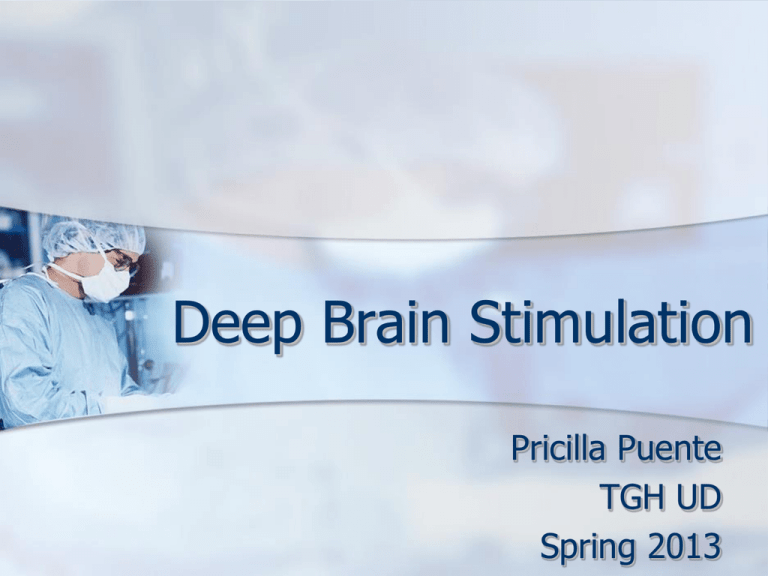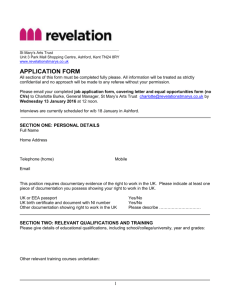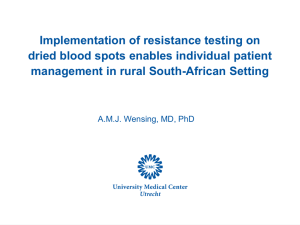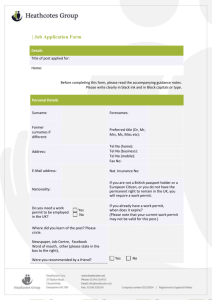Care of Surgical Clients - Pricilla Puente's Nursing Portfolio
advertisement

Deep Brain Stimulation Pricilla Puente TGH UD Spring 2013 Objectives Discuss the pathophysiology of Parkinson’s Disease (PD) Describe ways to know if a patient is a candidate for DBS therapy Describe how DBS therapy works Discuss benefits of DBS therapy List potential side effects and risks of DBS therapy Pathophysiology Parkinson’s Disease (PD) is a chronic progressive disease Degeneration of dopamine producing neurons in substantia nigra of midbrain (Osborn, Wraa, & Watson, 2010, p.798) Results in disturbed transmission of nerve impulses Pathophysiology Substantia nigra (located in midbrain) beneath basal ganglia Neurons in substantia nigra produce dopamine, a neurotransmitter necessary for smooth, voluntary movement In PD, neurons of substantia nigra begin to degenerate and die Results in lack of dopamine production Leads to patient signs/symptoms of PD (Osborn, Wraa, & Watson, 2010, p.798) Patient Signs/Symptoms Resting tremor Rigidity Bradykinesia Postural inability Begin to appear when approximately 70% of neurons in substantia nigra have degenerate and/or died (Osborn, Wraa, & Watson, 2010, p. 798) Prevalence Second to Alzheimer’s disease as most common of neurological degenerative disorders Most common movement disorder Estimated to affect about 1 million Americans with a lifetime risk of 1 in 40 to 50 Incidence increases with age, rising sharply after age 60; about 4% of cases occur before age 50 More common in relatives of PD patients (Osborn, Wraa, & Watson, 2010, p.798) Patient Scenario 78 year old male Had PD since 2002 (age of onset was 67 years old) Referred by physician for DBS therapy S/S: discomfort, trouble manipulating right hand, difficulty brushing teeth, brushing hair, bathing, writing, tremors, rigidity, bradykinesia, postural inability HPI: PD, hypotension, depression Objective Findings Pre-op: HR: 60 bpm BP: 90/70 mmHg Temp: 98.6 F SpO2: 92% Within a short time, patient noticed effects of medications wearing off and symptoms were worsening Secondary S/S incl dystonia and dyskinesia became severely disabling Nursing Diagnosis Impaired physical mobility related to rigidity, bradykinesia, postural instability, altered gait Impaired verbal communication related to voice and speech changes and decreased facial expression Disturbed thought processes (confusion, hallucinations, and delusions) related to cognitive changes, medication regimen, and/or infection (Osborn, Wraa, & Watson, 2010, p. 806) Adult failure to thrive r/t depression associated withchronic progressive disease Imbalanced nutrition less than body requirements r/t tremor, slowness in eating, difficulty in chewing and swallowing Risk for injury r/t tremors, slow reactions, altered gait (Ackley & Laddwig, 2011, p.85) Medications Carbidopa-Levadopa Dopamine Agonists MAOB Inhibitors COMT Inhibitors Anticholinergics Start low, go slow Fall prevention Hydration important to counteract low BP, constipation, general health (Osborn, Wraa, & Watson, 2010, p.800) Current Treatment: DBS Alternative treatment for PD and essential tremor that can improve motor function Surgical approach Placing electrodes in targeted areas of the brain Subthalmic nucleus Globus Pallidus Does not cure the disease, but may help lessen symptoms (Osborn, Wraa, & Watson, 2010, p. 804) In some cases, medications may still be needed, at lower doses, for certain conditions Does not damage nerve cells Can be reversed if needed (Jasmin, 2012) Health-related quality of life seems to improve to a greater extent in women (Hariz, Limousin, Zrino, Tripoliti, Aviles-Olmos, Jahanshahi, Hamberg, & Foltynie, 2013) Medications vs. DBS Medications Alone 0 hours of additional “on” time Unpredictable motor fluctuations Dyskinesias and nonmotor side effects DBS Therapy & Medications Average 5.1 hours additional “on” time without troubling dyskinesias More predictable motor fluctuations Medication reduction may lead to fewer druginduced side effects (Medtronic, 2013) Target Areas (Jasmin, 2012) Potential DBS Sites DBS Site *Subthalamic Nucleus (STN) Globus Pallidus internus (GPi) Ventralis intermediate nucleus of the thalamus (Vim) Therapeutic Effect(s) Reduction in tremor, rigidity, bradykinesia, and dyskinesia Same as above Reduction in tremor *STN DBS is currently most common target in PD (Jasmin, 2012) Candidates for DBS Diagnosis Advanced PD complicated by motor fluctuation, dyskinesia, or tremor despite optimized drug therapy Atypical parkinsonism and are not considered good candidates Age No cut-off point based on age Concerns with older age include increased comorbidities, cognitive decline, higher incidence of levadopa-resistant symptoms, and greater risk of complications Disease Duration Concern about operating on individual earlier than 5 years following diagnosis increases risk of operating on patients with atypical parkinsonism Levodopa Response Response to levadopa considered single best outcome predictor for response to DBS in parkinsonism Cognitive Impairment Dementia is most frequent exclusion criteria Advanced age may be associated with higher risk of frontal and related detioration following DBS of STN Psychiatric Issues Unstable psychiatric conditions Increased risk of suicide following DBS need for accurate preoperative psychiatric assessments, treatment of depression, and careful postoperative follow-op (Jasmin, 2012) Candidates for DBS Undergo a complete multidisciplinary screening with a neurologist, psychiatrist, neuropsychologist, neurosurgeon PD patients should undergo a “off/on” levadopa medication challenge to determine which symptoms responds best to medication—these usually are the ones that respond best to stimulation (Olanow, & Schapira, 2009) Medtronic 3-day “On” Time Diary How DBS Works (National Institutes of Health, 2012) How DBS Works (National Institutes of Health, 2012) DBS: Pre-Op Fit with sterotactic head frame MRI to map brain and identify area(s) in brain where electrodes will be placed NPO 6-12 hours prior to surgery (Jasmin, 2012) DBS: Intra-Op Part I: Brain Surgery Local anesthetic—don’t need an anesthetic in brain itself b/c brain has no pain receptors Patient awake and alert during procedure Surgeon implant thin wire lead with four electrodes at tips into specific area of brain Neurologist and surgeon monitor brain to ensure correct electrode placement Part II: Chest Wall Surgery General anesthesia used Surgeon implans pacemaker-like device that contains the batteries under skin in chest, near collarbone Wires from brain electrodes placed under skin and guided down to pulse generator –programmed to send continuous electrical pulses to brain (Massachusetts General Hospital, 2008) DBS: Post-Op Patient takes antibiotics to lower risk of infection Pulse generator in chest is activated in doctor’s office Doctor can program pulse generator from outside body using special remote control – amount of stimulation customized to patient’s condition Battery life varies with usage and setting—may last between 3-5 years and can be replaced during an outpatient procedure Once connected, the tiny pulses interfere with/block electrical signals that cause movement disorder symptoms (Jasmin, 2012) Patient Teaching DBS is not a cure for PD, but helps control symptoms DBS is not a substitute for medication use; drugs may still be needed to control symptoms Generally, symptoms that improve with levadopa administration will be improved with DBS The DBS system is composed of the lead wire, extension (connecting) wire, implanted neurostimulator, programmer, and patient controller and/or magnet (Massachusetts General Hospital, 2008) Batteries must be replaces every 3-5 years Complications Surgical procedure DBS system Infection, lead break, lead displacement, skin ulceration, misplacement/migration of the lead Stimulation Intracerebral hemorrhage, infarction, infection, seizures, pulmonary embolism Ocular and speech abnormalities, muscle twitches, paresthesias, depression, suicide, confusion, death (Olanow, & Schapira, 2009) Riskier in people over age 70 and those with comorbities like HTN and diseases that affect blood vessels in brain Research vs. Practice DBS is not for idiopathic parkinonism Examining additional targets that might benefit gait dysfunction, depression, cognitive impairment in PD More DBS and device-related studies are needed to know all adverse effects (Olanow, & Schapira, 2009) Changes in clinical symptoms can be associated with battery drain (Fakhar, Hastings, Butson, Foote, Zeilman, & Okhun, 2013) Prognosis Research being done: To determine its safety, reliability, and effectiveness as a treatment for PD To determine the site(s) in the brain where DBS surgery will be most effective in reducing PD symptoms To compare DBS to other PD therapies to find out which is more effective To study DBS as a treatment for epilepsy, cluster headaches, Tourette syndrome, chronic pain, major depressio (National Institutes of Health, 2012) Patient Outcome Decided to treat patient with DBP to left subthalmic nuclei on 3/1/2013 with a pulse generator placement 2 weeks later After treatment patient’s gait became normal, increased agility in upper extremities, dyskinesia and dystonia had disappeared Conclusion STN stimulation from DBS alone significantly improves smooth pursuit in patients with PD (Nilsson, Patel, Rehncrona, Magnusson, & Fransson, 2013) NCLEX Questions A patient asks what can be expected from DBS therapy for treatment of parkinsonism. The best response by the nurse would be: a. That a cure can be expected within 6 months b. That symptoms can be reduced, and the ability to perform ADLs can be improved c. That disease progression will be stopped d. That EPS will be prevented NCLEX Questions A patient asks what can be expected from DBS therapy for treatment of parkinsonism. The best response by the nurse would be: a. That a cure can be expected within 6 months b. That symptoms can be reduced, and the ability to perform ADLs can be improved c. That disease progression will be stopped d. That EPS will be prevented NCLEX Questions A client is scheduled to receive DBS therapy for relief of parkinsonian symptoms on 4/29/2013. Which of the following statements made by the client best indicates that the client needs further teaching? a. “My hands won’t be as shaky as they are now.” b. “The pulse generator battery re-charges itself, therefore it lasts a lifetime.” c. “I will be awake and alert during the brain surgery procedure.” d. “I cannot eat or drink for 6-12 hours before my surgery.” NCLEX Questions A client is scheduled to receive DBS therapy for relief of parkinsonian symptoms on 4/29/2013. Which of the following statements made by the client best indicates that the client needs further teaching? a. “My hands won’t be as shaky as they are now.” b. “The pulse generator battery re-charges itself, therefore it lasts a lifetime.” c. “I will be awake and alert during the brain surgery procedure.” d. “I cannot eat or drink for 6-12 hours before my surgery.” Helpful Sources Medtronic FAQs DBS Journey (short version) DBS Journey (long version) Medline Plus Long Video References Ackley, B.J., & Laddwig, G. B. (2011). Nursing Diagnosis Handbook. St. Louis, MO: Mosby, Inc. Fakhar, K., Hastings, E., Butson, C.R., Foote, K.D., Zeilman, P., & Okun, M.S. (2013). Management of deep brain stimulator battery failure: battery estimators, charge density, and importance of clinical symptoms. PLoS One, 8. Retrieved from http://www-ncbi-nlm-nih-gov.ezproxy.hsc.usf.edu/pubmed/23536810 Hariz, G.M., Limousin, P., Zrino, L., Tripoliti, E., Aviles-Olmos, I., Jahanshahi, M., Hamberg, K., & Foltynie, T. (2013). Gender differences in quality of life following subthalmic stimulation for Parkinson’s disease. Acta Neurologica Scandinavica. Retrieved from http://www-ncbi-nlm-nih-gov.ezproxy.hsc.usf.edu/pubmed/23550919 Jasmin, Luc. (2012). Deep Brain Stimulation. Retrieved from http://www.nlm.nih.gov/medlineplus/ency/article/007453.htm Massachusets General Hospital. (2008). Deep Brain Stimulation. In Comprehensive Clinical Psychiatry (Chapter 46: Neurotherapeutics). Retrieved from http://www.mdconsult.com.ezproxy.hsc.usf.edu/books/page.do?eid=4-u1.0-B978-0-323-04743-2..50048-2--cesec6&isbn=978-0-323-047432&sid=1426293494&uniqId=407266391-3#4-u1.0-B978-0-323-04743-2..50048-2--cesec6 Medtronic. (2013). DBS Therapy for Parkinson’s Disease. Retrieved from http://www.medtronicdbs.com/parkinsons/index.htm. National Institutes of Health. (2012). NINDS Deep Brain Stimulation for Parkinson’s Disease Information Page. Retrieved from http://www.ninds.nih.gov/disorders/deep_brain_stimulation/deep_brain_stimulation.htm Nilsson, M.H., Patel, M., Rehncrona, S., Magnusson, M., & Fransson, P.A. (2013). Subthalamic deep brain stimulation improves smooth pursuit and saccade performance in patients with Parkinson’s disease. Journal of Neuroengineering and Rehabilitation, 10. Retrieved from http://www-ncbi-nlm-nih-gov.ezproxy.hsc.usf.edu/pubmed/23551890 Olanow, C. W., & Schapira, A. H. (2009). Parkinson’s Disease and Related Disorders. In Harrison’s Online. (Section 2. Diseases of the CNS). Retrieved from http://www.accessmedicine.com.ezproxy.hsc.usf.edu/content.aspx?aID=9146572&searchStr=deep+brain+stimulation#9146572 Osborn, K.S., Wraa, C.E., & Watson A.B. (2010). Medical Surgical Nursing: Preparation for Practice. Upper Saddle River, NJ: Pearson.



